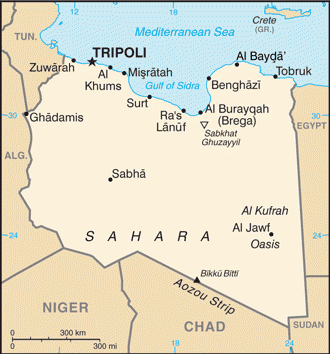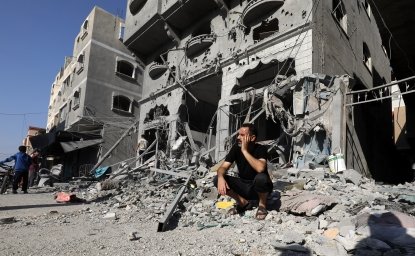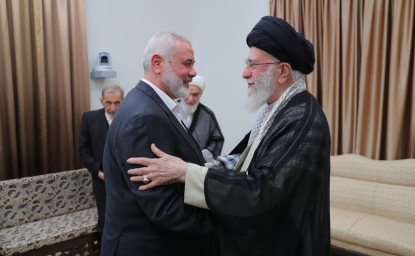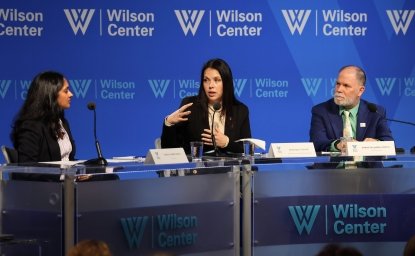By Cameron Glenn

Libya’s Islamists were imprisoned, forced underground or fled into exile during Moammar Qaddafi’s 42-year rule, but they re-emerged quickly after his capture in October 2011. They now span the ideological spectrum, from moderates who embrace democracy to militants with a global vision linked to al Qaeda. The factions include both political parties – defined largely by the Muslim Brotherhood and smaller Salafi groups – and militias. Although not all Islamist militias are tied to political parties, the major fighting groups do have political ties.
After Qaddafi’s ouster, Libya’s disparate array of Islamists transformed the political landscape. In 2014, Islamist militias forced the secular government to flee the capital. Due to growing clashes between Islamist and secular militias, Libya’s already fragile and factionalized political system imploded into two rival governments, each backed by loose coalitions of militias and tribes. By September 2016, a U.N.-backed unity government was in place, but some members of both rival governments refused to recognize its authority.
The situation was complicated by the growing presence of the Islamic State. In 2015, it won recruits from other jihadist groups and established a stronghold in Qaddafi’s hometown of Sirte. It maintained strong links to ISIS leadership in Iraq and Syria and even attempted to govern. But other militias - including both supporters and opponents of the unity government - had largely driven ISIS out of Sirte by September 2016.
Libya’s rapid deterioration is striking because it is the only one of the 22 Arab nations with the right assets – a small population and vast oil resources – that could afford both reconstruction and a political transition. Libya also had the potential to become a key economic player in North Africa and Southern Europe. But since early 2014, Libya has experienced its worst wave of violence since the 2011 uprisings, driving the country to civil war. The rivalries have played out among Islamist factions as well as between secular and Islamist parties.
Political Parties
After the 2011 uprisings that ousted Qaddafi, the Muslim Brotherhood emerged as Libya’s largest Islamist party. It held its first meeting in Benghazi just weeks after Qaddafi was captured. In March 2012, it formed the Justice and Construction Party, led by Mohammad Sawan, to run in elections. Other Islamists – notably Salafis – soon created a few smaller parties. One of the most prominent was the Watan Party led by Abdelhakim Belhadj, the former leader of the Libyan Islamic Fighting Group who was imprisoned under Qaddafi. Libya held elections in 2012 for the General National Congress, the centerpiece of new parliamentary rule. Islamist parties ran in both. In 2012, the National Forces Alliance, a loose coalition of secular and independent groups, won the largest bloc with 64 seats. The Muslim Brotherhood’s Justice and Construction Party took 34 seats, while Salafi parties picked up another 27 seats—a total of 61 seats for Islamists.
The key blocs – the National Forces Alliance, the Muslim Brotherhood, and the Salafis – ran on both party lists and as independents. (In the 2012 poll, 80 seats were allocated to parties, with the remaining 120 reserved for independents). The full results:
- The National Forces Alliance: 64 seats, including 39 party seats and 25 independent seats
- The Brotherhood’s Justice and Construction Party: 34 seats, including 17 party seats and 17 independent seats
- Salafis: 27 seats, including 4 party seats and 23 independent seats
Smaller national parties, local interest groups, and other independents: 75 seats, including 20 party seats and 55 independent seats
Once in parliament, the Brotherhood boosted its influence through strategic alliances with independents, which proved more cohesive than the secular coalition. It eventually became the strongest bloc in congress. In May 2013, the Brotherhood – with the support of Salafis – pushed through the controversial Political Isolation Law, which banned Qaddafi-era officials from participating in politics for ten years. The law weakened the National Forces Alliance by forcing several of its members to resign.
Yet the Brotherhood’s popular support has plunged since 2012. Many Libyans blamed Islamists for partisan bickering that stalled reconstruction. Secular politicians accused the Brotherhood and its affiliates of links to extremist groups, while Salafis claimed the Brotherhood compromised Islamic principles.
As a result, the Brotherhood fared even worse in the 2014 parliamentary elections than in 2012. It secured only 25 of the 200 available seats. Salafi parties also won a few seats.
Growing rivalries generally undermined the political process—and voter participation. Voter registration was almost halved: About 1.5 million Libyans registered to vote in the 2014 elections, compared to 2.8 million in 2012. Only 630,000 people actually voted. And polling stations in Derna, Kufra, and Sabha were closed due to violence. Libyans became increasingly disillusioned with political gridlock in parliament and the deteriorating security situation.
After Qaddafi’s ouster, Libya went through seven prime ministers during the first three years due to political turmoil. By mid-2017, there were three governments in Libya that did not recognize each other. Two governments were based in the capital, Tripoli: the Government of National Accord (GNA), which was backed by the United Nations and international community, and the General National Congress (GNC), also known as the National Salvation Government. In eastern Tobruk, a third government grew out of the House of Representatives, which was democratically elected in early summer 2014. It split from the GNC in late summer 2014. On July 25, 2017, the leaders of the GNA and Tobruk government agreed to both a nationwide ceasefire and to hold fresh parliamentary and presidential elections in spring 2018.
The Rise of Militias
The growing power of Libyan militias is a primary cause of the faltering political transition. Militias were initially formed to battle Qaddafi’s army during the eight-month uprising in 2011. Some were Islamist; some were secular. After his ouster, the transitional government, which preceded the General National Congress, coopted militias to fill the security vacuum. This policy led the number of militia fighters to swell quickly from 120,000 to more than 200,000, accounting for nearly 11 percent of the country’s workforce.
The various militias soon began to challenge Libya’s fledgling state institutions. In 2014, confrontations between Islamist and non-Islamist militias escalated in both western and eastern Libya. Tripoli in the west and Benghazi in the east are historic rivals.
In the east, Islamist militias – some affiliated with al Qaeda, and others tied to the Muslim Brotherhood—have steadily increased their numbers and weaponry since the 2011 uprising. In May 2014, they were challenged by General Khalifa Haftar, a renegade officer from the Libyan military, and his secular militia. Hardline Islamist groups, including Ansar al Sharia, formed the Shura Council of Benghazi Revolutionaries to fight Haftar’s militia. In July 2014, they seized control of Benghazi and declared it an Islamic caliphate. Gen. Haftar continued to contest Benghazi; he launched a new offensive in October 2014. After a three-year campaign, Haftar and his Libya National Army liberated Benghazi on July 5, 2017.
The Political Breakdown
In the west, the key turning point was the June 2014 election of Prime Minster Abdullah al Thinni. He only lasted two months. A coalition of Islamist militias from Misrata, known as Libya Dawn, drove the elected government of al Thinni out of Tripoli in August. Libya Dawn then supported creation of a rival government in Tripoli under Omar al Hassi, a former member of the Libyan Islamic Fighting Group. It included other Islamist members of the previous parliament.
Al Thinni and his elected government were forced to flee to remote Tobruk on the eastern coast. Libya’s Supreme Court – still seated in Tripoli – declared the parliament in Tobruk unconstitutional in November. By early 2015, Libya’s democratically elected government had few powers; it relied on secular militias with fewer resources than the Islamists.
The involvement of other Middle East countries and outside powers has further complicated the situation. Turkey and Qatar backed the Islamist government in Tripoli. The United States, Egypt, the United Arab Emirates (UAE) and Russia supported the elected government in Tobruk. In 2014, the UAE and Egypt conducted airstrikes on Islamist militias in Tripoli.
In December 2015, delegates from the two governments signed a U.N.-brokered agreement to form a unity government. Around 80 out of 188 members of the House of Representatives attended the signing ceremony in Skhirat, Morocco, along with 25 out of 200 members of the General National Congress. But key leaders – including Tripoli’s first deputy president Awad Abdul Saddeq – opposed the unity government and disowned those who backed it.
Despite lacking formal approval from either government, a nine-member presidential council, led by Fayez al Sarraj, was tasked with appointing a cabinet. Efforts initially stalled over disagreements about who should be included in the cabinet. In late March 2016, Sarraj’s government, known as the Government of National Accord (GNA) arrived in Tripoli. But it still faced opposition from some members of the GNC who refused to recognize the new government’s authority.
The Islamic State
In 2014, the appearance of the Islamic State in Libya further complicated the range of militias. The embryo was created by fighters who returned from Syria. They have been most active in Derna, an eastern city of 100,000 with a strong jihadist history since the 1980s. Men from Derna fought in Afghanistan against the Soviets in the 1980s, in Iraq against the United States in the early 2000s, and in Syria against the Damascus government in recent years.
Around 300 ISIS fighters in Derna formed the Shura Council of Islamic Youth in April 2014, and formally declared allegiance to the Islamic State (also known as ISIS, ISIL or Daesh) in October. Baghdadi accepted the pledges of bayat, or loyalty, and declared three “provinces” in Libya:
- The ISIS Tripolitania Province, in the west, succeeded in seizing former Libyan dictator Muammar Qaddafi’s hometown of Sirte in early 2015. By 2016, ISIS fighters – supported by former Ansar al Sharia members and an influx of foreign fighters—held about 250km of coastline. Most of ISIS was expelled from Sirte in December 2016 after a six-month campaign by Misratan militias, backed by U.S. air strikes.
- The ISIS Cyrenaica Province (formally known as the Islamic Shura Youth Council), in the east, has focused on establishing a foothold in Benghazi and Derna. Islamic State leader Abu Bakr al Baghdadi declared Derna—but not Benghazi--an official ISIS province in November 2014. It seized full control of Derna a month later. The Derna affiliate mobilized support among other Islamist brigades, including Ansar al Sharia. It has fought the local al Qaeda ally, the Abu Salim Martyrs Brigade. In 2016, ISIS was forced from the eastern city, but retains a presence in other areas of the country, including the west.
- The ISIS Fezzan Province emerged in 2014 in southern Libya. It engaged primarily in small-scale attacks on local forces. In January 2015, it attacked a Libyan army checkpoint in Sokhna that killed 16 people. The Fezzan Province was the weakest of the three Islamic State territories, although the Libyan defense minister charged that fighters were regrouping in the Fezzan Province after their defeats in Derna and Sirte. The U.S. States Country Reports on Terrorism 2016 said, “Many members of the terrorist organization fled to Libya’s western and southern deserts, abroad, or into neighboring urban centers.”
By March 2016, ISIS had between 5,000 and 6,000 fighters in Libya. While around 70 percent of ISIS fighters in Sirte were foreigners, the group also attracted defectors from other Libyan jihadist groups. ISIS has clashed with other jihadist groups, but reportedly fought alongside other Islamist militias against Haftar in Benghazi.
ISIS’s Libya affiliate – its strongest outside Iraq and Syria – has been linked to high-profile attacks across the country and abroad, including the Manchester bombing, which killed 22 people and injured 116, on May 22, 2017. ISIS leader Abu Bakr al Baghdadi reportedly has more direct authority over Libyan fighters than any of its other affiliates. By early 2016, ISIS had sent at least six senior leaders to Libya. One of them was a Mauritanian national named Abu Omar, who took charge of ISIS forces in Sirte and sought to prepare a possible refuge for ISIS commanders under attack in Iraq and Syria. Libya’s ISIS branch has even attempted to govern, setting up Islamic court systems and extracting taxes and fees from residents in the areas it controls. ISIS has also carried out attacks across the country, including in Zliten, Khums, Tripoli, Sabratha, Derna, and Ajdabiya.
Yet ISIS has also suffered setbacks in Libya’s messy civil war. It lost its stronghold in Sirte and control over Derna. It lost as many as 1,700 fighters in the battle for Sirte alone—from a total of between 5,000 to 6,000 troops nationwide. But the number of fighters fluctuates and is difficult to determine at any single time. “Those who survived the battle in Sirte, or didn’t take part in it, could have fled for neighboring countries, such as Tunisia or Egypt. They also could have retreated to other African nations, or further “abroad” to the Islamic State’s heartland in Iraq and Syria,” wrote Thomas Joscelyn of the Foundation for Defense of Democracies.
Divisions among Libya’s Islamists
Islamist parties and militias are often as hostile to each other as they are to non-Islamists. Libya’s branch of the Muslim Brotherhood, for example, was considered more moderate and willing to coexist with secular parties in the new government. Hardline Islamists, notably Salafis, often considered the Brotherhood to be sell-outs. Among the incidents that reflect internal tensions:
- In western Libya, Salafis, particularly those affiliated with Saudi preacher Rabi al Madkhali, have been attacking Sufi mosques, shrines, and graves since 2012. Sufis practice a mystical form of Islam, which Salafis believe to be heretical.
- In eastern Libya, hardline Islamist militias have bombed the cars and offices of Muslim Brotherhood politicians. Bombings and assassinations by hardline Islamists like Ansar al Sharia have become common in the east since 2011, but over time their targets expanded from Qaddafi-era officials to include moderate Islamists.
- In Tripoli, the Libya Dawn coalition denounced Ansar al Sharia as a terrorist group in August 2014. The same week, Ansar al Sharia issued a statement condemning the Muslim Brotherhood and its support for democracy.
- In Derna, the Shura Council of Islamic Youth and the Abu Salim Martyrs Brigade, both extremist factions with similar ideologies and goals, began openly battling each other for control of the city in September 2014.
Diverse clan, tribal, and geographic affiliations in Libyan society also complicate the divide between Islamists and non-Islamists. In mid-2014, Islamist militias from Misrata coordinated their attack on the central government in Tripoli with secular fighters and ethnic Amazigh Berbers.
The Militias: Who They Are
Libya’s Islamists span the spectrum of ideologies. They range from pro-democracy militias, with ties to politicians or parties, to groups linked with al Qaeda and the Islamic State. By early 2016, likeminded Islamist militias had banded together in loose coalitions across the country – most notably Libya Dawn in the west, and jihadist coalitions in Derna, Benghazi, and Ajdabiya in the east. The following are descriptions of the major (but not all) Islamist militias operating in Libya as of August 2017.
Libya Dawn
Libya Dawn is a coalition of powerful militias that back the Islamist-dominated General National Congress in Tripoli. It is primarily active in the western part of the country, and controls major coastal cities between Misrata and the Tunisian border. While a range of armed groups – including secular militias and tribal fighters – have joined the coalition, it is dominated by Islamist militias. Libya Dawn has generally tried to distance itself from extremist groups – in August 2014, it issued a statement expressing support for democracy. But some members of the Islamist coalition reportedly have ties to Ansar al Sharia and other militias in the east. By March 2016, the coalition had begun to fracture along political and geographic lines. Misratan militias and the Libyan Revolutionaries Operations Room are two major Islamist factions in the coalition.
Misratan Militias
The western city of Misrata became a stronghold for Islamist militias during the 2011 uprising. It eventually produced more than 200 militias with a total of 40,000 fighters. Some received funding from the General National Congress, one of Libya’s three rival governments. Other Misratan fighters support the U.N.-backed unity government. Some brigades also have had links to Muslim Brotherhood politicians. In 2016, Misratan militias fought ISIS in its stronghold of Sirte.
The Libyan Revolutionaries Operations Room
The Libyan Revolutionaries Operations Room is an umbrella for Islamist militias created and funded by the General National Congress in 2013 to provide security in Tripoli and Benghazi. It is led by two Islamists, Shaaban Hadia and Adel Gharyani. The group supported Islamist interests in the national assembly. It briefly kidnapped former Prime Minister Ali Zeidan in October 2013. In July 2014, the group vowed to take up arms against Gen. Haftar’s forces in Benghazi. In August 2014, it joined the Libya Dawn coalition, alongside the Misratan militias, during the attack on Tripoli that forced Prime Minister al Thinni to flee and led to the declaration of Omar al Hassi’s rival government.
In February 2016, the Libyan Revolutionaries Operations rejected the GNA – the U.N.-backed unity government—and vowed to fight if it moved back to Tripoli. Despite the threat, Prime Minister Fayez al Sarraj and six other senior GNA officials arrived in Tripoli and took control of government offices a month later. The militia joined the Libyan National Guard, a new umbrella group for opposition militias, in February 2017.
Benghazi Revolutionaries Shura Council
Jihadist groups active in Benghazi formed an alliance in July 2014 to fight Gen. Haftar’s forces. Ansar al Sharia and the 17 February Martyrs Brigade are two key militias in the alliance.
Ansar al Sharia (Dissolved)
Ansar al Sharia was a hardline group created in June 2012 by militants who fought in the 2011 uprising. It was widely suspected of having links to al Qaeda, but its leaders have denied these claims. It sought to establish strict Islamic rule in Libya. Ansar al Sharia was linked to the attack on the U.S. mission in Benghazi and the death of U.S. Ambassador Christopher Stevens on Sept. 11, 2012. The group had been battling Gen. Haftar’s forces since May 2014. It announced its dissolution in late May 2017 after many of its leaders and soldiers were killed.
17 February Martyrs Brigade
The 17 February Martyrs Brigade, one of the largest and best armed militias in eastern Libya, was formed by members of the Muslim Brotherhood during the 2011 uprising. The Brigade, which previously received funding from Libya’s Defense Ministry, has carried out law enforcement functions in southern and eastern Libya. It is based in Benghazi and battled Gen. Haftar’s forces throughout 2014. Several hundred fighters reportedly left the group to join Ansar al Sharia in 2012, but the two groups maintain close ties.
Derna Mujahideen Shura Council
Jihadist groups in Derna – including Ansar al Sharia – formed the Derna Mujahideen Shura Council in December 2014. They originally collaborated to fight Gen. Haftar’s forces, but they also fought ISIS and succeeded in expelling the group from Derna in 2015. The alliance of militias reportedly has ties to al Qaeda. The Abu Salim Martyrs Brigade is one of the main militias in the alliance.
The Abu Salim Martyrs Brigade
The Abu Salim Martyrs Brigade was formed in 2011 by Islamists detained in the Abu Salim prison under Qaddafi. It was the most powerful militia in Derna until ISIS-linked groups emerged in late 2014. The Brigade calls for strict enforcement of Sharia, but advocates Libyan nationalism rather than creation of a caliphate. It battled ISIS-linked militias for control of Derna in 2015.
Ajdabiya Revolutionaries Shura Council
The Ajdabiya Revolutionaries Shura Council, backed by Ansar al Sharia and allied with the Benghazi Revolutionaries Shura Council, was formed in March 2015. It has fought tribal forces loyal to Gen. Haftar in Ajdabiya, a coastal town west of Benghazi and close to several key oil terminals. It seized southern parts of the city in 2015, but lost significant territory to Haftar in February 2016. Militants claiming to be from the Ajdabiya Revolutionaries Shura Council released a video pledging support to ISIS. But the group’s leader, Mohammad al Zawi, has denied the links, insisting that the fighters did not speak on behalf of the group.
Cameron Glenn was a senior program assistant at the U.S. Institute of Peace when this chapter was originally published in March 2016. Mattisan Rowan, a research assistant at USIP, updated this chapter in July 2017.
Photo credits: Abdullah al Thinni by U.S. Department of State (cropped)
Author

The Islamists
Learn more about Hamas and how it relates to similarly aligned organizations throughout the region. Read more

Explore More
Browse Insights & Analysis
Israel Escalates Attacks in Gaza: What’s Next?

Israel Expands Operations on Multiple Fronts: Perspectives on the Conflict

